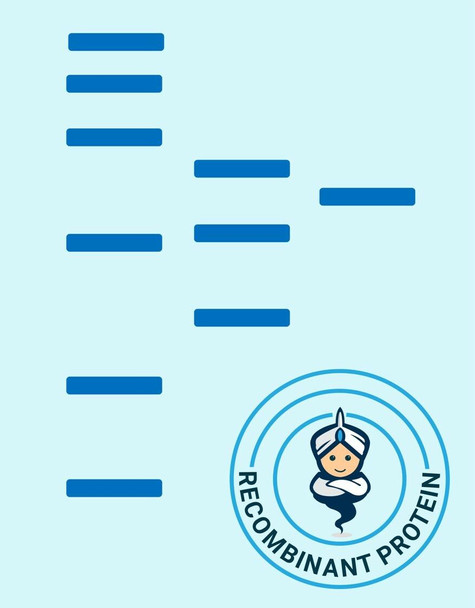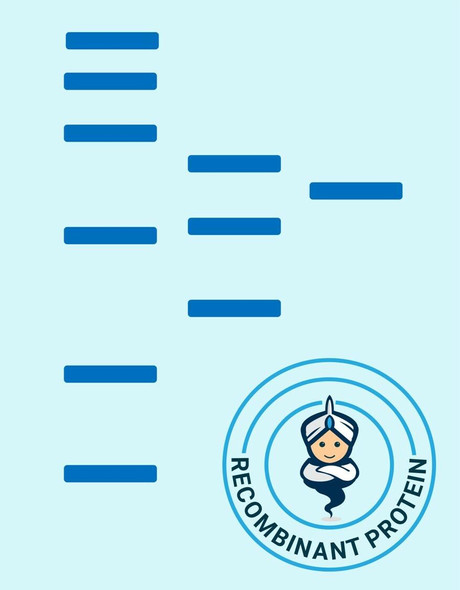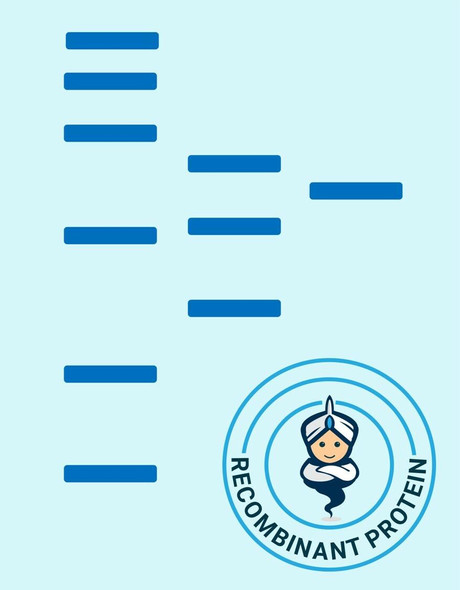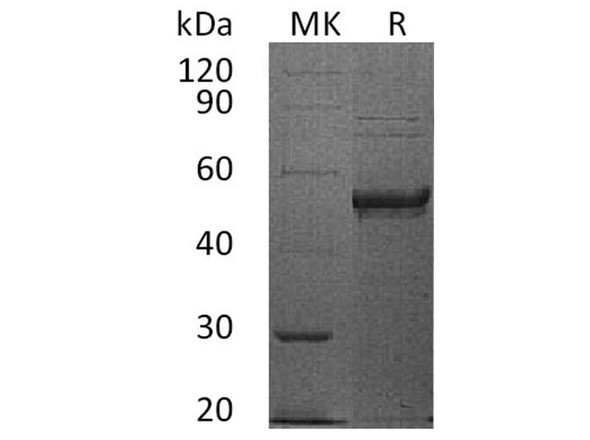Cytokines Recombinant Proteins
Human TNFRSF14 Recombinant Protein (RPPB1035)
- SKU:
- RPPB1035
- Product Type:
- Recombinant Protein
- Species:
- Human
- Uniprot:
- Q92956
- Research Area:
- Cytokines
Description
| Product Name: | Human TNFRSF14 Recombinant Protein |
| Product Code: | RPPB1035 |
| Size: | 5µg |
| Species: | Human |
| Target: | TNFRSF14 |
| Synonyms: | Tumor necrosis factor receptor superfamily member 14 isoform 1, TNFRSF14, ATAR, CD270, HVEA, HVEM, LIGHTR, TR2, HVEM-Fc, Sf9, Tumor necrosis factor receptor superfamily member 14, Herpes virus entry mediator A, Herpesvirus entry mediator A, HveA. |
| Source: | Sf9 Insect cells |
| Physical Appearance: | Sterile Filtered clear solution. |
| Formulation: | TNFRSF14 protein solution (0.25mg/ml) containing Phosphate Buffered Saline (pH 7.4) and 10% glycerol. |
| Stability: | Store at 4°C if entire vial will be used within 2-4 weeks. Store, frozen at -20°C for longer periods of time. For long term storage it is recommended to add a carrier protein (0.1% HSA or BSA).Avoid multiple freeze-thaw cycles. |
| Purity: | Greater than 90.0% as determined by analysis by SDS-PAGE. |
| Amino Acid Sequence: | ADPLPSCKED EYPVGSECCP KCSPGYRVKE ACGELTGTVC EPCPPGTYIA HLNGLSKCLQ CQMCDPAMGL RASRNCSRTE NAVCGCSPGH FCIVQDGDHC AACRAYATSS PGQRVQKGGT ESQDTLCQNC PPGTFSPNGT LEECQHQTKC SWLVTKAGAG TSSSHWVLEP KSCDKTHTCP PCPAPELLGG PSVFLFPPKP KDTLMISRTP EVTCVVVDVS HEDPEVKFNW YVDGVEVHNA KTKPREEQYN STYRVVSVLT VLHQDWLNGK EYKCKVSNKA LPAPIEKTIS KAKGQPREPQ VYTLPPSRDE LTKNQVSLTC LVKGFYPSDI AVEWESNGQP ENNYKTTPPV LDSDGSFFLY SKLTVDKSRW QQGNVFSCSV MHEALHNHYT QKSLSLSPGK HHHHHH |
TNFRSF14, a member of the TNF receptor superfamily, is a type I transmembrane protein. TNFRSF14 is expressed in peripheral blood T cells, B cells, monocytes and in various tissues enriched in lymphoid cells. TNFRSF14 operates as a co-stimulatory factor for the activation of lymphoid cells and as a deterrent to infection by herpesvirus. Additionally, TNFRSF14 encourages the proliferation of T cells, and triggers apoptosis of various tumor cells.
TNFRSF14 Human Recombinant produced in Sf9 Baculovirus cells is a single, glycosylated polypeptide chain containing 406 amino acids (39-202) and having a molecular mass of 46.6kDa (Molecular size on SDS-PAGE will appear at approximately 40-57kDa).TNFRSF14 is fused to a 239 amino acid IgG His-Tag at C-terminus and purified by proprietary chromatographic techniques.
| UniProt Protein Function: | TNFRSF14: Receptor for BTLA. Receptor for TNFSF14/LIGHT and homotrimeric TNFSF1/lymphotoxin-alpha. Involved in lymphocyte activation. Plays an important role in HSV pathogenesis because it enhanced the entry of several wild-type HSV strains of both serotypes into CHO cells, and mediated HSV entry into activated human T-cells. |
| UniProt Protein Details: | Protein type:Receptor, misc.; Membrane protein, integral; Cell cycle regulation Chromosomal Location of Human Ortholog: 1p36.32 Cellular Component: integral to plasma membrane; plasma membrane; external side of plasma membrane Molecular Function:viral receptor activity; protein binding; tumor necrosis factor receptor activity; ubiquitin protein ligase binding Biological Process: positive regulation of peptidyl-tyrosine phosphorylation; defense response to Gram-positive bacterium; entry of virus into host cell; cell surface receptor linked signal transduction; tumor necrosis factor-mediated signaling pathway; T cell costimulation; positive regulation of cytokine secretion during immune response; negative regulation of alpha-beta T cell proliferation; immune response; defense response to Gram-negative bacterium |
| NCBI Summary: | This gene encodes a member of the TNF (tumor necrosis factor) receptor superfamily. The encoded protein functions in signal transduction pathways that activate inflammatory and inhibitory T-cell immune response. It binds herpes simplex virus (HSV) viral envelope glycoprotein D (gD), mediating its entry into cells. Alternative splicing results in multiple transcript variants. [provided by RefSeq, Jul 2014] |
| UniProt Code: | Q92956 |
| NCBI GenInfo Identifier: | 13878821 |
| NCBI Gene ID: | 8764 |
| NCBI Accession: | Q92956.3 |
| UniProt Secondary Accession: | Q92956,Q6IB95, Q8N634, Q8WXR1, Q96J31, Q9UM65, B3KW30 B9DI89, |
| UniProt Related Accession: | Q92956 |
| Molecular Weight: | 283 |
| NCBI Full Name: | Tumor necrosis factor receptor superfamily member 14 |
| NCBI Synonym Full Names: | tumor necrosis factor receptor superfamily, member 14 |
| NCBI Official Symbol: | TNFRSF14�� |
| NCBI Official Synonym Symbols: | TR2; ATAR; HVEA; HVEM; CD270; LIGHTR�� |
| NCBI Protein Information: | tumor necrosis factor receptor superfamily member 14; CD40-like protein; herpes virus entry mediator A; tumor necrosis factor receptor-like gene2; tumor necrosis factor receptor superfamily, member 14 (herpesvirus entry mediator) |
| UniProt Protein Name: | Tumor necrosis factor receptor superfamily member 14 |
| UniProt Synonym Protein Names: | Herpes virus entry mediator A; Herpesvirus entry mediator A; HveA; Tumor necrosis factor receptor-like 2; TR2; CD_antigen: CD270 |
| Protein Family: | Tumor necrosis factor receptor superfamily |
| UniProt Gene Name: | TNFRSF14�� |
| UniProt Entry Name: | TNR14_HUMAN |






